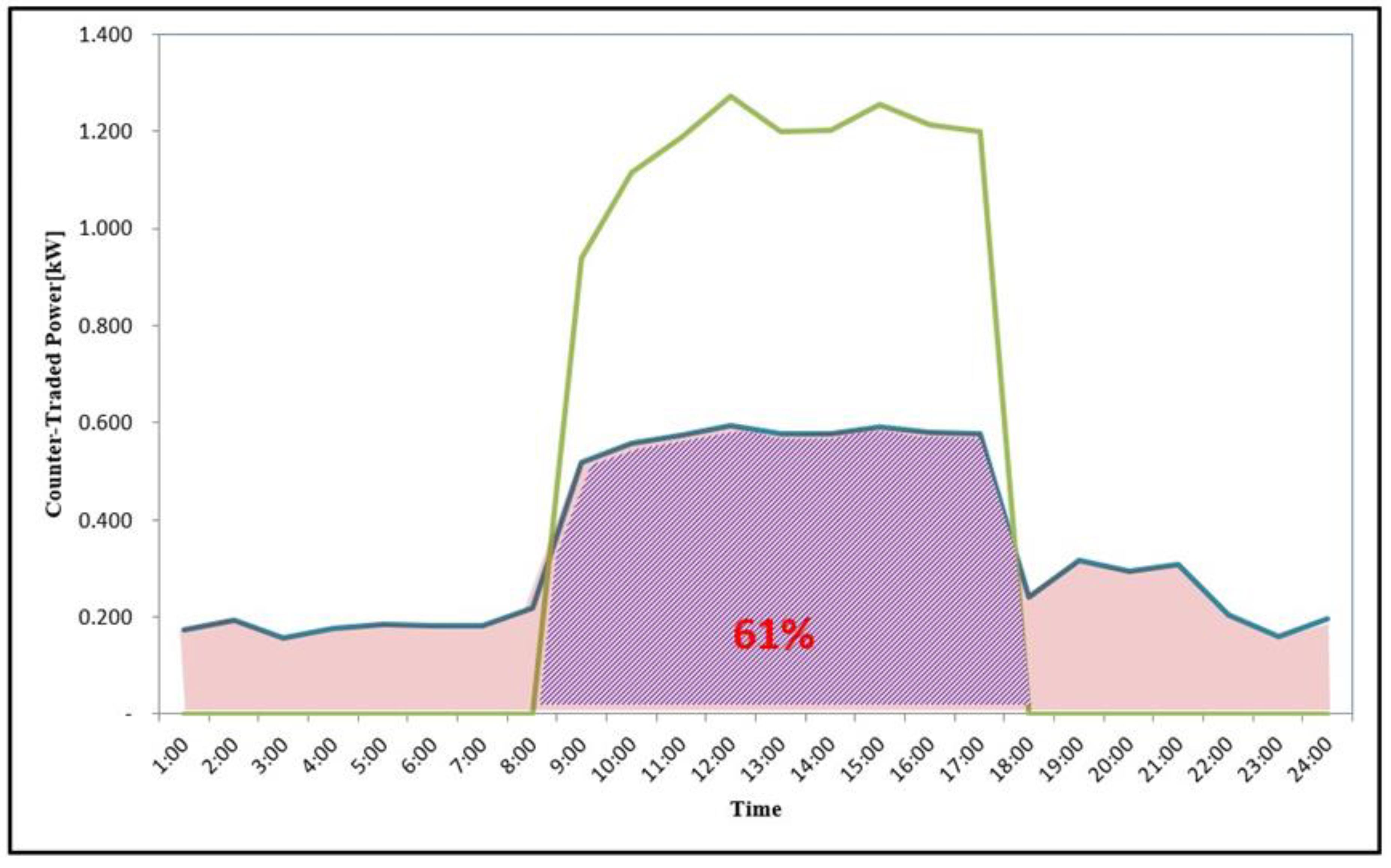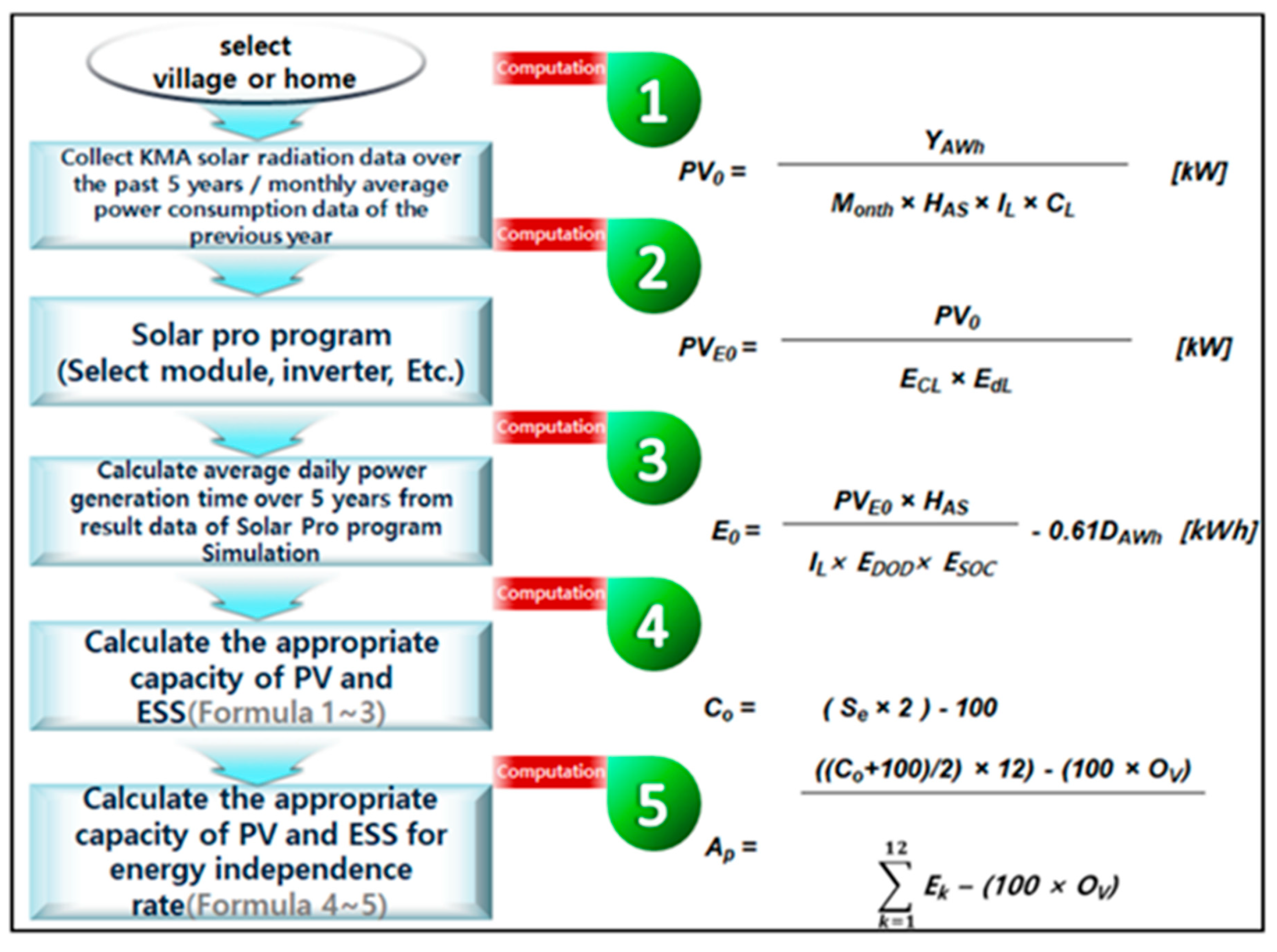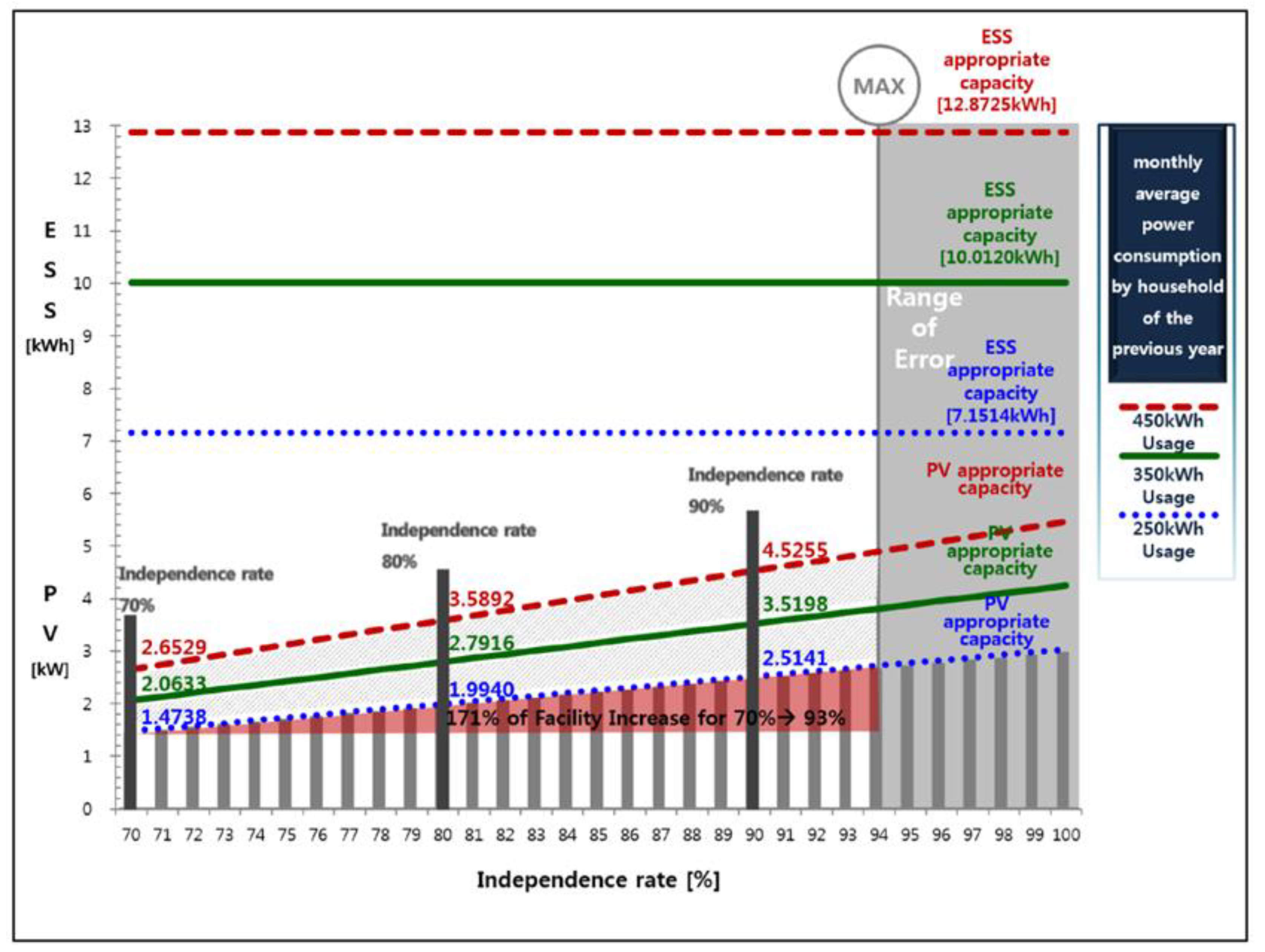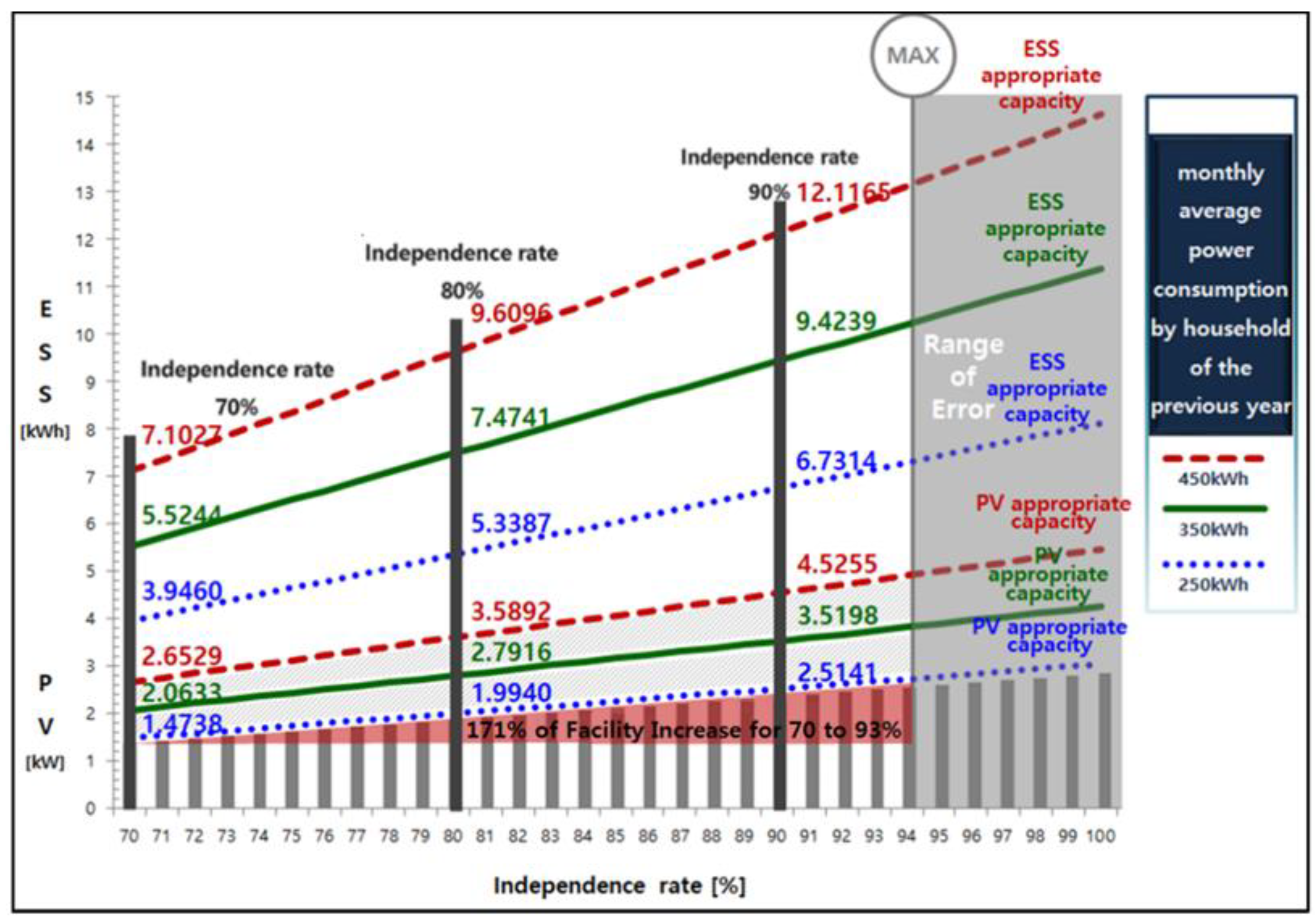Convergence Analysis of Capacities for Photovoltaics and Energy Storage System Considering Energy Self-Sufficiency Rates and Load Patterns of Rural Areas
Abstract
1. Introduction
2. Data Collection from the Target Area
2.1. Area Data of Energy Self-Sufficient Households
2.2. Study of the Monthly Average Energy Use of 905 Households
2.3. Examination on Counter-Traded Power for Households Using an Average of 250 kWh in a Month
3. Calculation Method for the Optimized Capacity of the PV and ESSs with 90% Energy Self-Sufficiency
3.1. Calculation Method for Optimized PVs Capacity
- PV0 = Optimized capacity of PVs
- YAWh = Average energy usage per month in last year (kWh)
- Month = 1 month (365/12; day)
- HAS = Daily insolation hour of the area in the last year (h)
- IL = Power loss in Inverter (0.965)
- CL = Power loss in Cable (0.9926)
- PVEo = Optimized capacity of PVs considering the charge/discharge losses
- ECL = Energy loss in charging ESS
- EDL = Energy loss in discharging ESS
3.2. Calculation Method for Optimized ESS Capacity
- EO = Optimized capacity of ESS
- PVEO = Optimized capacity of PVs
- PL = PCS loss (0.965)
- HAS = Daily average insolation of the area in the previous year (h)
- Dawh = Daily average power usage (kWh)
- EDOD = Depth of discharge (0.9)
- ESOC = State of charge (0.9)
4. Calculation of Generation Time for Energy Self-Sufficiency of 90% with PVs and ESSs
- C0 = (Se × 2) − 100
- C0 = Correlation coefficient
- Se = self-sufficiency (%)
- Ap = Application coefficient
- Ov = Number of households that had over a 100% generation time efficiency per month
- Ek = Sum of efficiency from January to December
- C0 = (90 × 2)−100 = 80
5. Conclusions
Author Contributions
Funding
Conflicts of Interest
References
- Zafar, U.; Rashid, T.U.; Khosa, A.A.; Khalil, M.S.; Rashid, M. An overview of implemented renewable energy policy of Pakistan. Renew. Sustain. Energy Rev. 2018, 82, 654–665. [Google Scholar] [CrossRef]
- Fernando, Y.; Bee, P.S.; Jabbour, C.J.C.; Thomé, A.M. Understanding the effects of energy management practices on renewable energy supply chains: Implications for energy policy in emerging economies. Energy Policy 2018, 118, 418–428. [Google Scholar] [CrossRef]
- Karunathilake, H.; Perera, P.; Ruparathna, R.; Hewage, K.; Sadiq, R. Renewable energy integration into community energy systems: A case study of new urban residential development. J. Clean. Prod. 2018, 173, 292–307. [Google Scholar] [CrossRef]
- He, J.; Zhao, C.; Cai, L.; Cheng, P.; Shi, L. Practical closed-loop dynamic pricing in smart grid for supply and demand balancing. Automatica 2018, 89, 92–102. [Google Scholar] [CrossRef]
- Das, S.; Akella, A.K. Power flow control of PV-wind-battery hybrid renewable energy systems for stand-alone application. Int. J. Renew. Energy Res. (IJRER) 2018, 8, 36–43. [Google Scholar]
- Chung, D.W.; Yang, S.H. SOC estimation of lithium-ion battery based on kalman filter algorithm for energy storage system in microgrids. E3S Web Conf. 2018, 57, 02006. [Google Scholar] [CrossRef]
- Berrueta, A.; Heck, M.; Jantsch, M.; Ursúa, A.; Sanchis, P. Combined dynamic programming and region-elimination technique algorithm for optimal sizing and management of lithium-ion batteries for photovoltaic plants. Appl. Energy 2018, 228, 1–11. [Google Scholar] [CrossRef]
- Park, S.; Kim, Y.M.; Lee, P.Y.; Kim, J. A study on application of the Lithium-ion battery for coping with extended station blackout. In Proceedings of the 2018 53rd International Universities Power Engineering Conference (UPEC), Glasgow, UK, 4–7 September 2018; pp. 1–5. [Google Scholar]
- Ibrahim, H.; Ilinca, A.; Perron, J. Energy storage systems—Characteristics and comparisons. Renew. Sustain. Energy Rev. 2008, 12, 1221–1250. [Google Scholar] [CrossRef]
- Liu, N.; Cheng, M.; Yu, X.; Zhong, J.; Lei, J. Energy-sharing provider for pv prosumer clusters: A hybrid approach using stochastic programming and stackelberg game. IEEE Trans. Ind. Electron. 2018, 65, 6740–6750. [Google Scholar] [CrossRef]
- Palm, J.; Eidenskog, M.; Luthander, R. Sufficiency, change, and flexibility: Critically examining the energy consumption profiles of solar PV prosumers in Sweden. Energy Res. Soc. Sci. 2018, 39, 12–18. [Google Scholar] [CrossRef]
- Wu, X.; Hu, X.; Teng, Y.; Qian, S.; Cheng, R. Optimal integration of a hybrid solar-battery power source into smart home nanogrid with plug-in electric vehicle. J. Power Sources 2017, 363, 277–283. [Google Scholar] [CrossRef]
- Wu, X.; Hu, X.; Yin, X.; Zhang, C.; Qian, S. Optimal battery sizing of smart home via convex programming. Energy 2017, 140, 444–453. [Google Scholar] [CrossRef]
- Lee, C.; Bhang, B.; Kim, D.; Lee, S.; Cha, H.; Ahn, H. Estimation of load pattern for optimal planning of stand-alone microgrid networks. Energies 2018, 11, 2012. [Google Scholar] [CrossRef]
- Cha, H.L.; Bhang, B.G.; Park, S.Y.; Choi, J.H.; Ahn, H.K. Power prediction of bifacial Si PV module with different reflection conditions on rooftop. Appl. Sci. 2018, 8, 1752. [Google Scholar] [CrossRef]
- Lee, H.G.; Kim, G.-Y.; Bhang, B.G.; Kim, D.K.; Park, N.; Ahn, H.-K. Design Algorithm for Optimum Capacity of ESS Connected with PVs Under the RPS Program. IEEE Access 2018, 6, 45899–45906. [Google Scholar] [CrossRef]
- Renewable Energy Certificate. Available online: https://www.knrec.or.kr/business/rps_guide.aspx (accessed on 20 February 2019).
- Greenhome Project. Available online: http://greenhome.kemco.or.kr/index.do (accessed on 9 April 2019).
- System Marginal Price. Available online: http://www.kemco.or.kr/web/kem_home_new/info/dictionary/voca/kem_view.asp?sch_search=&sch_key=dic_word&sch_value=%EA%B3%84%ED%86%B5%ED%95%9C%EA%B3%84%EA%B0%80%EA%B2%A9&h_page=1&q=1426 (accessed on 20 February 2019).
- Khatib, T.; Mohamed, A.; Sopian, K. A review of photovoltaic systems size optimization techniques. Renew. Sustain. Energy Rev. 2013, 22, 454–465. [Google Scholar] [CrossRef]
- Kim, G.G.; Choi, J.H.; Park, S.Y.; Bhang, B.G.; Nam, W.J.; Ahn, H.K. Prediction model for PV performance with correlation analysis of environmental variables. IEEE J. Photovolt. 2019, 9, 832–841. [Google Scholar] [CrossRef]
- Wang, F.; Li, K.; Wang, X.; Jiang, L.; Ren, J.; Mi, Z.; Shafie-khah, M.; Catalão, J. A distributed PV system capacity estimation approach based on support vector machine with customer net load curve features. Energies 2018, 11, 1750. [Google Scholar] [CrossRef]
- Cho, C.-Y.; Kim, S.-S.; Lee, H.G.; Ko, J.-W.; Lim, J.-R.; Woo, S.C.; Cha, H.-L.; Kim, D.K.; Ahn, H.K. Optimal design of renewable energy resources considering electric load control for carbon free Jeju island in Korea. In Proceedings of the European Photovoltaic Solar Energy Conference and Exhibition, Munich, Germany, 21 June 2016. [Google Scholar]






| Households | 1 | 2 | … | 904 | 905 | Average | |
|---|---|---|---|---|---|---|---|
| Month | |||||||
| January | 55 | 489 | ~ | 130 | 144 | 232 | |
| February | 88 | 249 | 179 | 107 | 236 | ||
| March | 44 | 162 | 135 | 103 | 205 | ||
| April | 66 | 148 | 142 | 117 | 222 | ||
| May | 207 | 184 | 137 | 114 | 216 | ||
| June | 77 | 254 | 149 | 127 | 213 | ||
| July | 78 | 349 | 158 | 186 | 230 | ||
| August | 97 | 428 | 165 | 198 | 262 | ||
| September | 76 | 400 | 130 | 151 | 220 | ||
| October | 103 | 246 | 142 | 116 | 225 | ||
| November | 43 | 368 | 149 | 115 | 225 | ||
| December | 45 | 315 | 158 | 121 | 226 | ||
| Total | 979 | 3592 | 1.774 | 1599 | 2712 | ||
| Category | Number of Households | Portion |
|---|---|---|
| 50–100 kWh | 15 | 1.66% |
| 100–200 kWh | 134 | 14.81% |
| 200–300 kWh | 304 | 33.59% |
| 300–400 kWh | 257 | 28.40% |
| Category | Average Power Generated (kWh/day) | Average Number of Generating Hour (h/day) | Average of Generation Efficiency | Generation Efficiency Limited to 100% |
|---|---|---|---|---|
| January | 8.73 | 3.15 | 88.61 | 88.61 |
| February | 9.61 | 3.47 | 97.57 | 97.57 |
| March | 11.70 | 4.23 | 118.75 | 100.00 |
| April | 11.72 | 4.23 | 118.94 | 100.00 |
| May | 12.52 | 4.52 | 127.09 | 100.00 |
| June | 11.38 | 4.11 | 115.48 | 100.00 |
| July | 9.04 | 3.27 | 91.74 | 91.74 |
| August | 9.52 | 3.44 | 96.63 | 96.63 |
| September | 10.30 | 3.72 | 104.51 | 100.00 |
| October | 9.75 | 3.52 | 98.92 | 98.92 |
| November | 7.06 | 2.55 | 71.62 | 71.62 |
| December | 7.01 | 2.53 | 71.10 | 71.10 |
| Average | 9.86 | 3.56 | 100.08 | 93.02 |
| Category | Average Generating Hour per Day (h) | Calculation Method (Ap = 0.9412651) | Average of Self-Sufficiency Set to 90% (%) |
| January | 3.15 | (3.15/3.56) × 0.9413 × 100 | 83.40 |
| February | 3.47 | (3.47/3.56) × 0.9413 × 100 | 91.83 |
| March | 4.23 | 100.00 | 100.00 |
| April | 4.23 | 100.00 | 100.00 |
| May | 4.52 | 100.00 | 100.00 |
| June | 4.11 | 100.00 | 100.00 |
| July | 3.27 | (3.27/3.56) × 0.9413 × 100 | 86.35 |
| August | 3.44 | (3.44/3.56) × 0.9413 × 100 | 90.95 |
| September | 3.72 | 100.00 | 100.00 |
| October | 3.52 | (3.52/3.56) × 0.9413 × 100 | 93.11 |
| November | 2.55 | (2.55/3.56) × 0.9413 × 100 | 67.41 |
| December | 2.53 | (2.53/3.56) × 0.9413 × 100 | 66.92 |
| Average | 3.56 | - | 90.00 |
© 2019 by the authors. Licensee MDPI, Basel, Switzerland. This article is an open access article distributed under the terms and conditions of the Creative Commons Attribution (CC BY) license (http://creativecommons.org/licenses/by/4.0/).
Share and Cite
Cho, C.Y.; Lee, W.; Bhang, B.G.; Choi, J.; Lee, S.H.; Woo, S.C.; Ahn, H.K. Convergence Analysis of Capacities for Photovoltaics and Energy Storage System Considering Energy Self-Sufficiency Rates and Load Patterns of Rural Areas. Appl. Sci. 2019, 9, 5323. https://doi.org/10.3390/app9245323
Cho CY, Lee W, Bhang BG, Choi J, Lee SH, Woo SC, Ahn HK. Convergence Analysis of Capacities for Photovoltaics and Energy Storage System Considering Energy Self-Sufficiency Rates and Load Patterns of Rural Areas. Applied Sciences. 2019; 9(24):5323. https://doi.org/10.3390/app9245323
Chicago/Turabian StyleCho, Choon Young, Wonbin Lee, Byeong Gwan Bhang, Jinho Choi, Sang Hun Lee, Sung Cheol Woo, and Hyung Keun Ahn. 2019. "Convergence Analysis of Capacities for Photovoltaics and Energy Storage System Considering Energy Self-Sufficiency Rates and Load Patterns of Rural Areas" Applied Sciences 9, no. 24: 5323. https://doi.org/10.3390/app9245323
APA StyleCho, C. Y., Lee, W., Bhang, B. G., Choi, J., Lee, S. H., Woo, S. C., & Ahn, H. K. (2019). Convergence Analysis of Capacities for Photovoltaics and Energy Storage System Considering Energy Self-Sufficiency Rates and Load Patterns of Rural Areas. Applied Sciences, 9(24), 5323. https://doi.org/10.3390/app9245323






